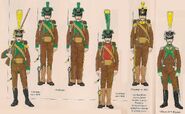(Добавление категорий) |
|||
| Строка 20: | Строка 20: | ||
==История== |
==История== |
||
Корсиканские тиральеры были сформированы 1802 г. |
Корсиканские тиральеры были сформированы 1802 г. |
||
| + | |||
| + | В 1811 г. вошли в состав [[11-й полк легкой пехоты (Франция)|11-го полка легкой пехоты]]. |
||
| + | |||
==Организация== |
==Организация== |
||
The Tirailleurs Corses was a single battalion unit composed of six field companies (a carabinier company, a voltigeur company, and four chasseur companies). The 7th Company was the depot company and was located in Corsica. On 10 August 1811, the battalion was disbanded and incorporated into the 11th Legere Regiment. At this time its strength was 18 officers and 679 enlisted men. Further evidence that this was a single battalion unit can be found on Page 469 of A. Marinien's Tableaux par Corps et par Batailles des Officiers Tues et Blesses pendent les Guerres de l'Empire. The unit is listed as the Bataillon de Tirailleurs Corses. |
The Tirailleurs Corses was a single battalion unit composed of six field companies (a carabinier company, a voltigeur company, and four chasseur companies). The 7th Company was the depot company and was located in Corsica. On 10 August 1811, the battalion was disbanded and incorporated into the 11th Legere Regiment. At this time its strength was 18 officers and 679 enlisted men. Further evidence that this was a single battalion unit can be found on Page 469 of A. Marinien's Tableaux par Corps et par Batailles des Officiers Tues et Blesses pendent les Guerres de l'Empire. The unit is listed as the Bataillon de Tirailleurs Corses. |
||
Версия от 17:10, 31 июля 2018
Корсиканские тиральеры — формирование лёгкой пехоты Великой армии, сформированное в 1802 г.
Термин тиральеры происходит от слова тир (фр. tir от глагола tirer — "тянуть, натягивать (лук), отсюда — стрелять"). Таким образом, тиральер — стрелок. Изначально в тиральеры брали новобранцев только из людей, прошедших огневую подготовку, то есть охотников. Суть их была, как и на охоте, стрелок-следопыт. В это соединение попадали так же жители острова Корсика, отсюда и название — корсиканские стрелки пехотинцы, от исходного слова "тир" — тиральеры.
История
Корсиканские тиральеры были сформированы 1802 г.
В 1811 г. вошли в состав 11-го полка легкой пехоты.
Организация
The Tirailleurs Corses was a single battalion unit composed of six field companies (a carabinier company, a voltigeur company, and four chasseur companies). The 7th Company was the depot company and was located in Corsica. On 10 August 1811, the battalion was disbanded and incorporated into the 11th Legere Regiment. At this time its strength was 18 officers and 679 enlisted men. Further evidence that this was a single battalion unit can be found on Page 469 of A. Marinien's Tableaux par Corps et par Batailles des Officiers Tues et Blesses pendent les Guerres de l'Empire. The unit is listed as the Bataillon de Tirailleurs Corses.
Униформа
Most sources have the Tirailleurs Corses wearing brown legere uniforms with green facings, cuffs, turnbacks, and collar. There was no piping on the collar or cuffs. Uniform cut, buttons, and equipment was the same for regular French light infantry regiments except for the cartridge box. It was worn on a waist belt in the front, instead of on the side. Two sources (Bucquoy and Knotel) show the belts and straps for the voltigeurs as white in 1809, but buff for the chasseurs in 1808 and 1810.
Epaulets: Chasseurs wore green epaulets, with yellow tops, while voltigeurs had yellow ones. Carabiniers probably wore red epaulets. Officers wore silver epaulets.
Headgear: Carabiniers wore a bearskin. Chasseurs wore the normal light infantry shako with green trim, cording, and pompom. Voltigeurs wore the same, except for yellow cording, trim, and plume. Shako plates were the 1806 diamond shaped regulation plate, made of white metal, with an eagle over a hunting horn. There was number stamped in the center of the horn.
Note: There is some contention in the color of the uniforms. Although most books give the uniform as being brown, Rigo states: "From the time of its creation on 15th March 1808 the Battalion was dressed in blue, faced with green. Notes preserved in the CARL Collection and also in the Military Alphabet give chestnut brown faced with green in 1809. We should not like to throw any doubt on the word of our distinguished predecessor, but on the other hand we know that no chestnut brown cloth is mentioned in the clothing returns dated 15th March 1808 at DEUX-PONTS which is preserved in the Vincennes Archives in file Xk 4. It is for this reason we have depicted our Sergeant-Major Standard-Bearer in the dress of 1804-1805." This is interesting. . . a close examination of the Bucquoy plates and the Knotel plates in Etling's book show very similar figures as if they used the same source to paint them. For example both have plates of a voltigeur for 1809, and a chasseur in 1808 wearing a brown uniform with red facings; yet neither show a carabinier. This leads to some possible speculation. Corsican Legion units were dressed in blue uniforms in the early 1800s but eventually switched to brown. . . Did this lead the original source (the ones Bucquoy and Knotel used) to assume that the Tirailleurs Corses also wore brown uniforms? The Tirailleurs Corses had their origins as the 3rd Battalion 8th Demi-Brigade and only became a separate unit on 5 December 1804.10 Did they change their uniforms when they became a separate battalion?
Флаг
The battalion received an eagle on 5 December 1804 and its flag was the standard French lozenge pattern. On the front was "L'EMPEUR DES FRANCASI, AU BATTALLION DE TIRAILLEURS CORSE", while the back had "VALEUR ET DISCIPLINE." There were gold wreaths in the corners, however there were no numbers inside the wreaths.
Галерея
Источники
- https://www.napoleon-series.org/military/organization/c_corses.html
- http://nacekomie.ru/forum/viewtopic.php?f=39&t=27233&sid=30b14311a0dd1558cf47b0343add5ffd&start=20



